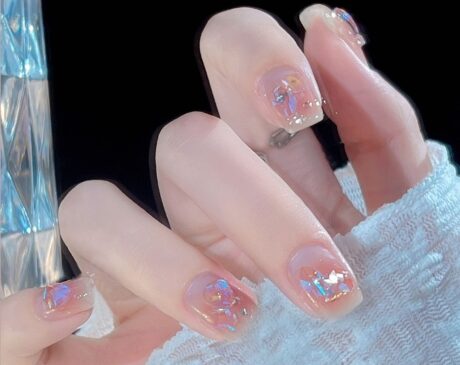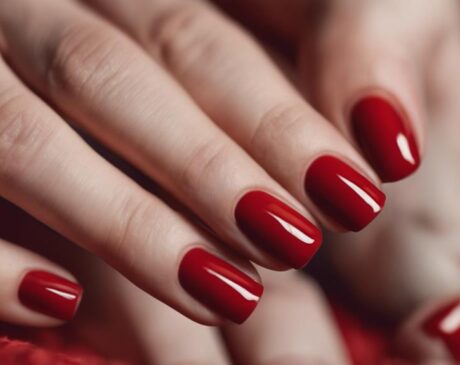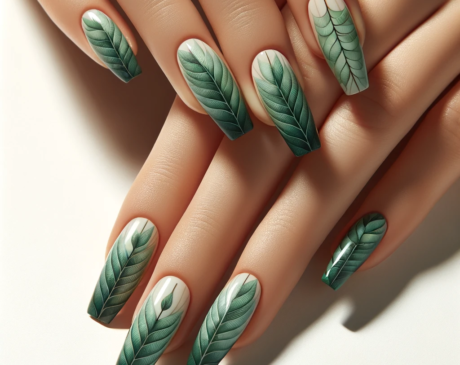What Happens if I Use Too Much Nail UV Light?

Excessive use of nail UV light can result in skin damage, such as redness, dryness, and age spots. This can also lead to weakened nails with dryness and brittleness. Prolonged exposure poses risks of skin cancer and premature aging due to the breakdown of collagen and elastin. Promptly recognizing signs like redness and dryness is crucial, and protection measures like sunscreen and UV-protective gloves are recommended. Safely curing nails with alternatives like LED lamps and natural sunlight is beneficial. Implementing protective measures and seeking professional advice are essential for skin and nail health. Explore further for detailed insights into UV light risks.
Key Takeaways
- Increased risk of skin damage and cancer due to excessive UV exposure.
- Nail dryness, brittleness, and discoloration may worsen with prolonged UV light use.
- Overexposure can lead to weakened nail structure and breakage over time.
- Long-term effects include premature aging, wrinkles, and immune system weakening.
- Seek professional advice for specialized nail care and UV light exposure risks.
Risks of UV Exposure

Excessive exposure to UV light during nail treatments can pose serious risks to both clients and technicians. While UV light is commonly used in salons for curing gel nail polish quickly, prolonged and repeated exposure can lead to skin damage, premature aging, and an increased risk of skin cancer. Clients may experience skin redness, dryness, and a higher likelihood of developing age spots on their hands from the UV exposure. Technicians are also at risk, as their hands are often exposed to UV light for extended periods while performing nail services, potentially leading to similar skin issues.
Innovations in the industry have led to the development of safer alternatives, such as LED nail lamps that emit lower levels of UV light and cure gel polish more efficiently. Additionally, using broad-spectrum sunscreen on hands before UV exposure and wearing protective gloves during nail treatments can help reduce the risks associated with UV exposure in salons. By staying informed about the potential dangers of UV light and adopting these innovative practices, both clients and technicians can prioritize their health and safety during nail treatments.
Impact on Nail Health
Regular exposure to UV light during nail treatments can have detrimental effects on the health and condition of nails over time. Prolonged exposure to UV light can lead to dryness, brittleness, and discoloration of the nails. This occurs because the UV light depletes the natural oils in the nails, making them more prone to breakage and damage. Additionally, UV light can cause the nails to become thinner and more fragile, resulting in a weakened nail structure.
To better understand the impact of UV light on nail health, let's explore the following table:
| Effects of UV Light on Nails | Description |
|---|---|
| Dryness | UV light can strip the nails of natural oils, leading to dry and brittle nails. |
| Brittleness | Nails may become more prone to breakage and damage due to UV light exposure. |
| Discoloration | Prolonged UV exposure can cause nails to become discolored or yellowed. |
| Thinning | UV light can result in thinner and more fragile nails over time. |
Skin Damage

Prolonged exposure to UV light during nail treatments can also negatively impact the skin, leading to potential damage and concerns. While UV light is primarily used to cure gel polishes and strengthen nails, it can inadvertently harm the skin surrounding the nails. The skin on the hands is delicate and susceptible to UV damage, which can result in issues such as premature aging, sunspots, and an increased risk of skin cancer.
UV exposure can break down collagen and elastin in the skin, accelerating the aging process and causing wrinkles and fine lines to appear more prominently. Additionally, repeated UV exposure can lead to the development of sunspots, also known as age spots, which are areas of hyperpigmentation on the skin.
Furthermore, UV radiation is a known carcinogen, and excessive exposure can increase the risk of developing skin cancer on the hands and surrounding areas. To mitigate these risks, it is crucial to protect the skin during nail treatments by applying sunscreen or wearing protective gloves.
Signs of Overexposure
Symptoms of excessive UV light exposure during nail treatments can manifest in various ways, indicating potential overexposure to harmful radiation. Common signs of overexposure to UV light during nail treatments include redness, dryness, and a burning sensation on the skin surrounding the nails. Additionally, individuals may experience an increased sensitivity to touch in the affected areas. It is crucial to recognize these symptoms promptly to prevent further damage and seek appropriate medical advice if needed.
| Signs of Overexposure to UV Light | Description | Actions |
|---|---|---|
| Redness | Skin appears red or flushed around the nails | Reduce exposure time and apply aloe vera gel |
| Dryness | Skin feels dry and tight near the nails | Moisturize the affected area regularly |
| Burning Sensation | Skin feels hot or burns when touched | Stop treatment immediately and seek medical advice |
Monitoring these signs and taking necessary precautions can help prevent long-term effects of overexposure to UV light during nail treatments.
Long-Term Effects

The cumulative exposure to excessive UV light during nail treatments may result in long-term effects on the skin and overall health. Prolonged exposure to UV light can lead to premature aging of the skin, including the development of wrinkles, age spots, and a loss of skin elasticity. Furthermore, UV radiation is a known risk factor for skin cancer, and repeated exposure can increase the likelihood of developing skin malignancies over time.
Beyond skin concerns, excessive UV light exposure can also have systemic effects on overall health. Studies have suggested that prolonged exposure to UV radiation may weaken the immune system, making individuals more susceptible to infections and illnesses. Additionally, UV radiation can contribute to the development of eye conditions such as cataracts.
To mitigate these long-term effects, it is crucial to practice moderation when using UV light for nail treatments and to prioritize skin and overall health by implementing appropriate protection measures.
UV Protection Tips
Excessive exposure to UV light during nail treatments necessitates implementing effective UV protection tips to safeguard skin and overall health. With a growing concern over the potential risks associated with UV light exposure, innovative solutions have emerged to provide protection without compromising the quality of nail treatments. One of the key UV protection tips is to apply a broad-spectrum sunscreen with a high SPF on your hands before undergoing any UV nail treatment. This helps to create a barrier against harmful UV rays and reduces the risk of skin damage. Additionally, wearing UV protective gloves during the nail curing process can significantly minimize direct exposure to UV light. Investing in specially designed gloves that allow for dexterity while blocking UV rays is a proactive measure to prioritize skin health. Lastly, incorporating regular breaks during UV nail treatments can give the skin a chance to recover and reduce the cumulative effects of UV exposure. By following these UV protection tips, individuals can enjoy their nail treatments while maintaining skin safety and overall well-being.
Alternatives to UV Light

When considering the risks associated with excessive UV light exposure during nail treatments, exploring alternatives becomes essential. LED lamps offer a safer option for curing gel nails, reducing the potential harm caused by prolonged UV exposure. Additionally, embracing natural sunlight can provide a gentle yet effective alternative for drying nail polish without the use of artificial UV light sources.
UV Light Risks
While UV light is commonly used in nail salons for curing gel manicures, there are alternative methods available to minimize the risks associated with UV light exposure. Here are three innovative alternatives:
- Water-based Gel Polishes: These polishes can be cured using natural light, eliminating the need for UV exposure.
- Powder Dip Systems: This method involves dipping nails in colored powder, which is then sealed with a clear coat that dries without UV light.
- Non-UV LED Lamps: LED lamps emit lower levels of UV light compared to traditional UV lamps, reducing the risk of overexposure while curing gel nails efficiently.
LED Lamps Option
An effective alternative to traditional UV light for curing gel nails is the use of Non-UV LED lamps, which emit lower levels of UV light, reducing the risk of overexposure while still ensuring efficient curing. LED lamps are popular for their quick curing times, often taking only 30-60 seconds per layer compared to UV lamps which can take 2-3 minutes. Additionally, LED lamps have a longer lifespan, are more energy-efficient, and are available in portable sizes for at-home or professional use. Their versatility allows for curing various types of gel polish, making them a convenient and safer option for individuals concerned about UV exposure. As technology advances, LED lamps continue to innovate, offering a promising solution for nail curing needs.
Natural Sunlight Benefits
UV light exposure can be minimized by exploring the benefits of natural sunlight as an alternative method for curing gel nails. Natural sunlight offers a safer option for nail curing while providing additional benefits:
- Vitamin D Synthesis: Sunlight exposure aids in the production of vitamin D, crucial for overall health and well-being.
- Cost-Effective: Utilizing natural sunlight is a budget-friendly approach compared to investing in UV lamps.
- Environmental Friendly: By opting for natural sunlight, you reduce energy consumption and minimize your carbon footprint.
Embracing natural sunlight not only promotes healthier nails but also aligns with sustainable practices, offering a holistic approach to nail care.
Seeking Professional Advice

When it comes to the potential risks associated with using too much nail UV light, it is crucial to consult with experts in the field. Professional guidance is highly recommended to ensure the safety and health of your nails. Seeking specialized nail care can provide personalized advice tailored to your specific needs and concerns.
Consult With Experts
Seeking professional advice from experienced nail technicians or dermatologists is crucial when dealing with the effects of excessive nail UV light exposure. Consulting with experts in the field can provide valuable insights and guidance on how to mitigate any potential risks or damage caused by overexposure to UV light during nail treatments. Here are three key reasons why seeking professional advice is essential:
- Customized Recommendations: Experts can offer personalized recommendations based on your unique skin type and nail health.
- Risk Assessment: Professionals can assess the level of risk associated with UV exposure and provide strategies to minimize any adverse effects.
- Treatment Options: Dermatologists and nail technicians can suggest alternative treatments or products to help repair and protect your nails and skin.
Professional Guidance Recommended
Considering the potential risks associated with excessive exposure to nail UV light, it is imperative to seek professional guidance to safeguard your nail and skin health effectively. Professionals in the field can provide tailored advice on UV light exposure, nail care routines, and potential risks associated with overuse. Below is a table showcasing some key reasons why seeking professional guidance is essential in maintaining healthy nails and skin:
| Reasons to Seek Professional Guidance | Benefits | Outcome |
|---|---|---|
| Tailored advice on UV light exposure | Personalized recommendations for safe usage | Minimized risk of skin damage |
| Expert nail care routines | Optimal nail health strategies | Stronger and healthier nails |
| Risk assessment of overuse | Early detection of potential issues | Prevention of long-term damage |
Seeking professional guidance ensures that you receive expert advice and personalized care, ultimately leading to healthier nails and skin.
Seek Specialized Nail Care
To ensure optimal nail health and minimize the risks associated with UV light exposure, consulting a professional nail care expert is crucial. Nail specialists possess the knowledge and skills to assess your nails' condition accurately and provide tailored recommendations for UV light exposure and overall nail care. Here are three reasons why seeking specialized nail care is beneficial:
- Personalized Advice: Professionals can offer personalized advice based on your nail type and concerns.
- Risk Assessment: They can assess the risks associated with UV light exposure and suggest appropriate preventive measures.
- Advanced Treatments: Nail care experts can provide advanced treatments to repair any damage caused by excessive UV light exposure.
Frequently Asked Questions
Can UV Nail Lights Cause Allergic Reactions?
UV nail lights can potentially trigger allergic reactions due to prolonged exposure. The emitted UV radiation can sensitize the skin, leading to redness, itchiness, or even dermatitis. It's crucial to monitor exposure and seek medical advice if symptoms arise.
Is It Safe to Use UV Lights During Pregnancy?
Using UV lights during pregnancy raises concerns due to potential risks associated with exposure. Consult a healthcare provider for guidance. Innovative alternatives like LED nail lamps may offer a safer option for pregnant individuals.
Can UV Exposure Increase the Risk of Cancer?
UV exposure can indeed increase the risk of skin cancer. Like a double-edged sword, while UV light can provide benefits like vitamin D production, excessive exposure can damage skin cells and potentially lead to cancer development.
How Often Should UV Nail Light Bulbs Be Replaced?
UV nail light bulbs should be replaced every 6 months to maintain optimal performance for curing gel polish effectively. Regular replacement ensures consistent results and reduces the risk of incomplete curing, leading to longer-lasting and professionally finished nails.
Are There Specific Nail Conditions Worsened by UV Exposure?
Excessive UV exposure during nail treatments may exacerbate nail conditions, such as fungal infections, dryness, and discoloration. Awareness of these risks underscores the importance of balancing UV light usage for optimal nail health and aesthetics.




